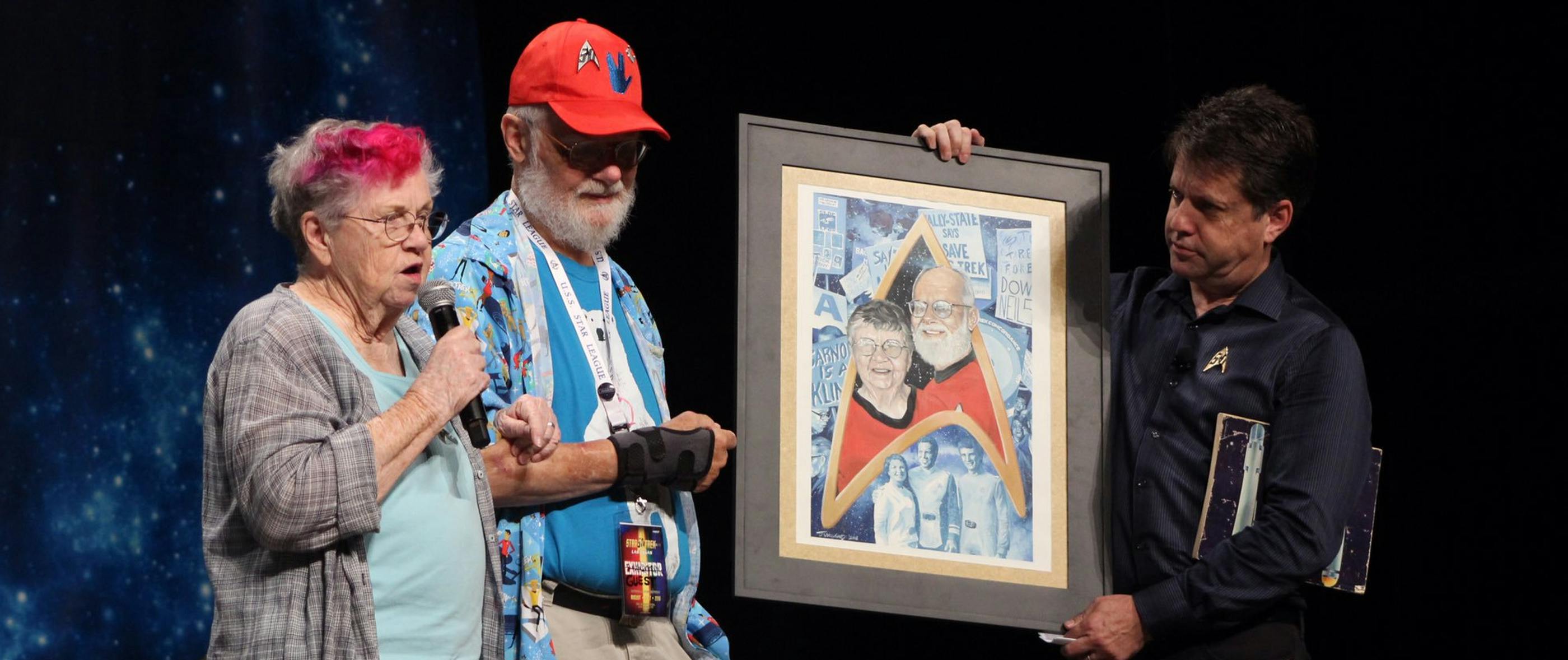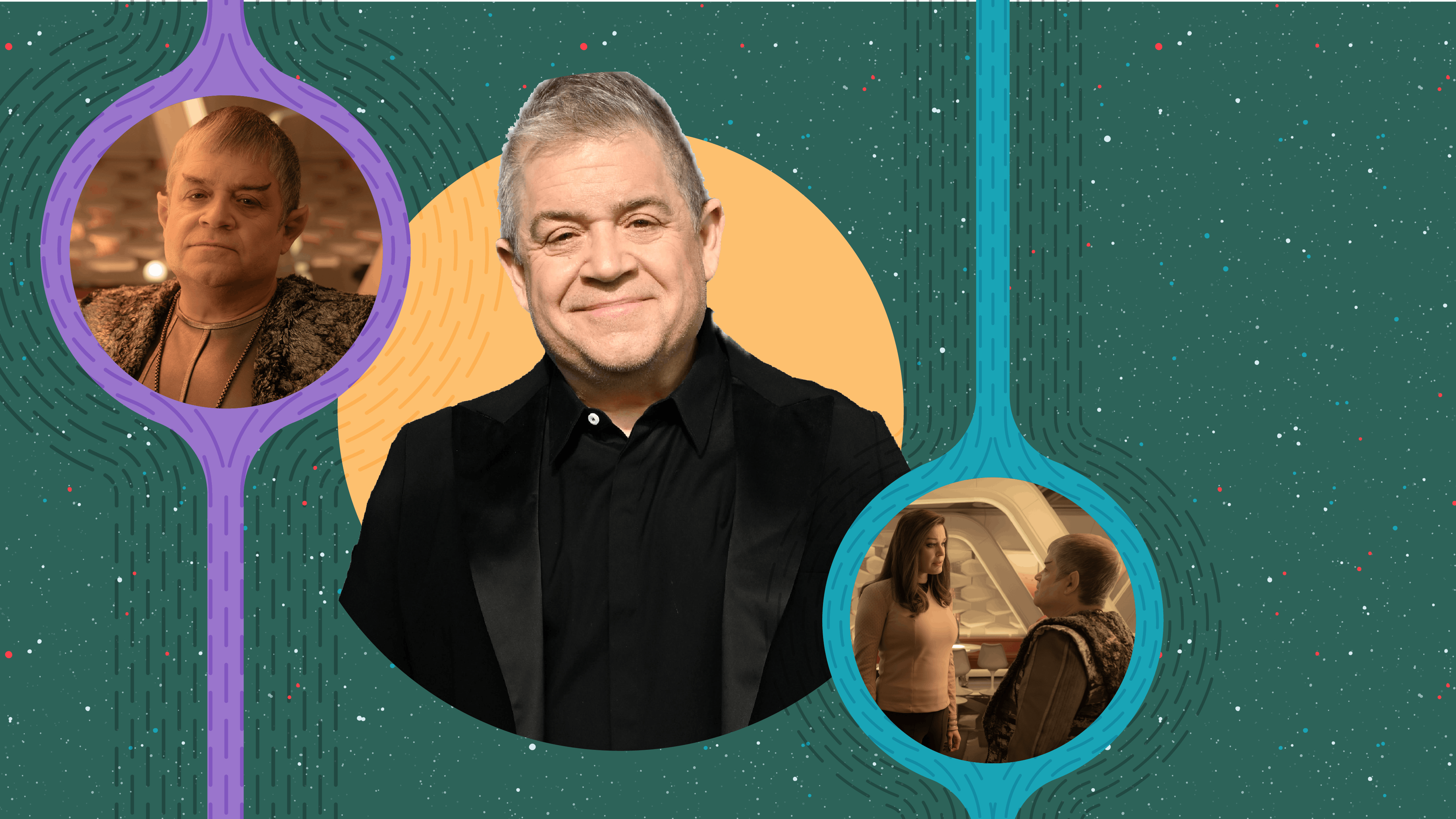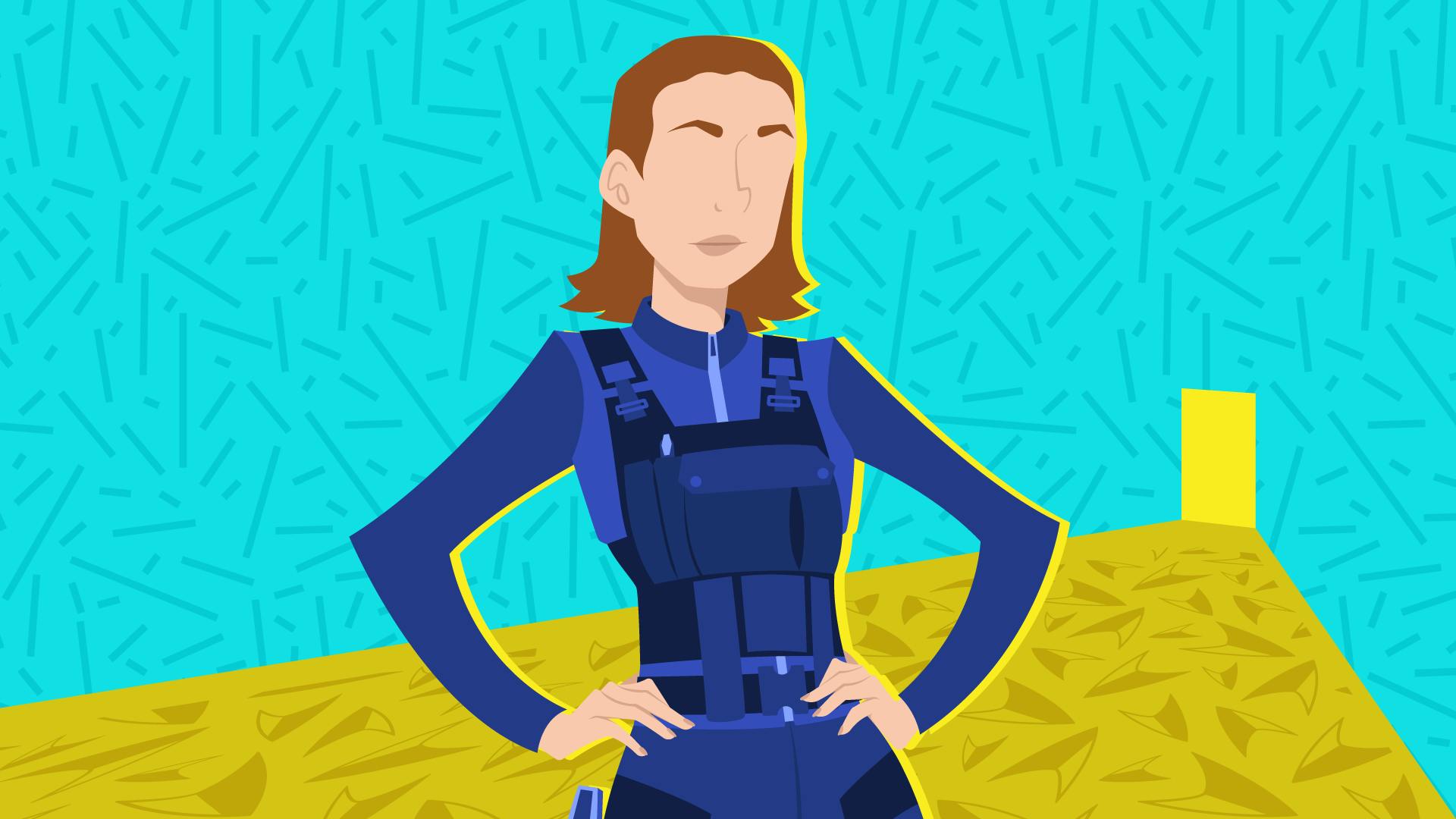Published Dec 12, 2023
Bjo Trimble: The Woman Who Saved Star Trek
Looking back on the Trimbles' letter writing campaign.
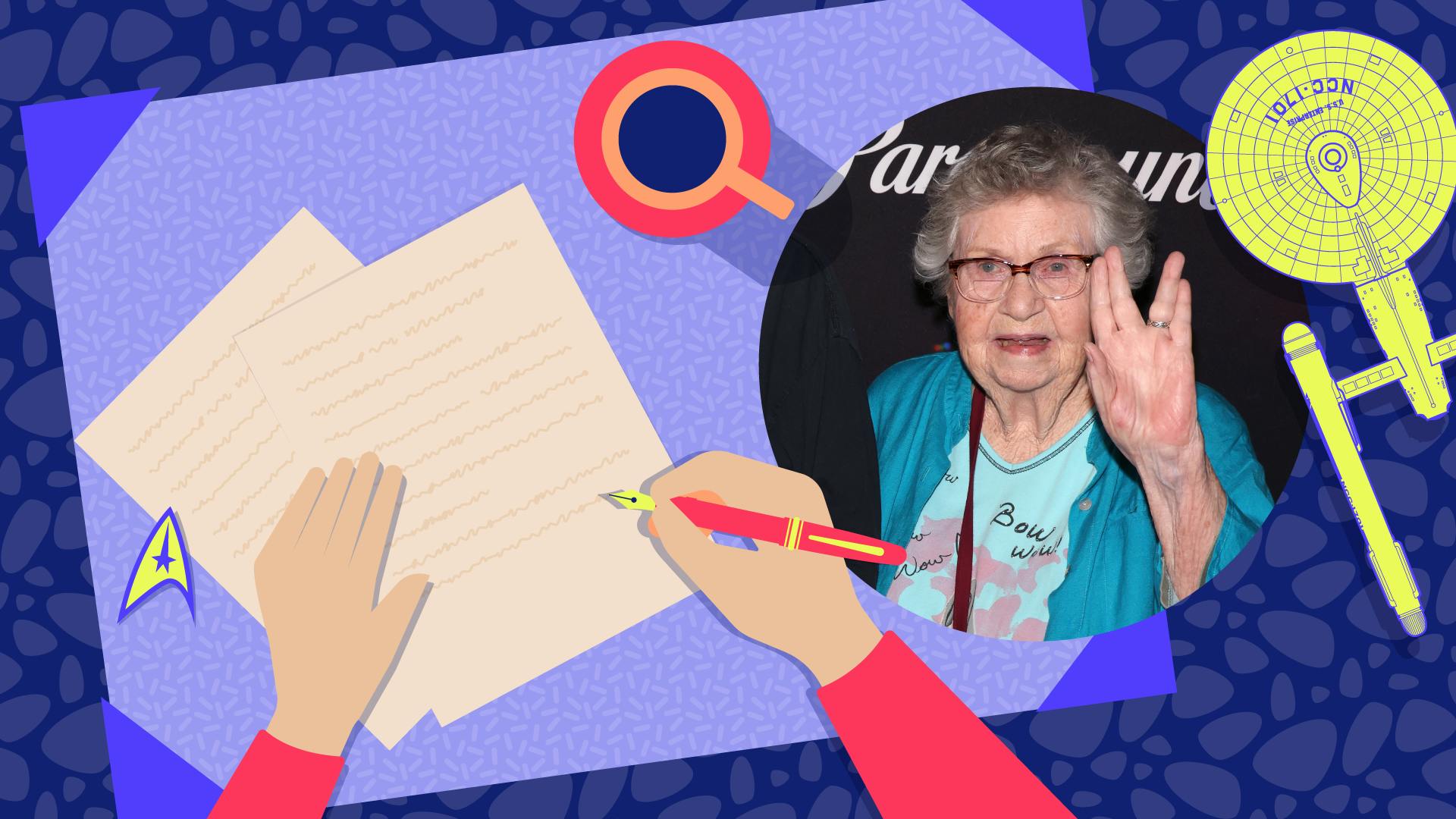
Getty Images / StarTrek.com
As we close out another great year in the Star Trek universe, we're taking some time to recognize that there might have been nothing to celebrate, or certainly a whole less less, were it not for the efforts of Bjo and John Trimble.
Longtime fans surely know the story, but newer fans may not, and it’s time to re-tell the tale and pass it on for a new generation. We can't think of a better time as this week marks the 55th anniversary of their letter writing campaign.
For the record, when NBC seemed to be on the verge of axing Star Trek after a low-rated second season, the Trimbles devised a grassroots letter-writing campaign that saved the show and resulted in a third season. Though the network dropped Star Trek after its lackluster third year, enough episodes had been shot for the show to enter syndication. And, it was during its syndicated run that Star Trek emerged as such a phenomenon that it was resurrected as and, in 1979, a .
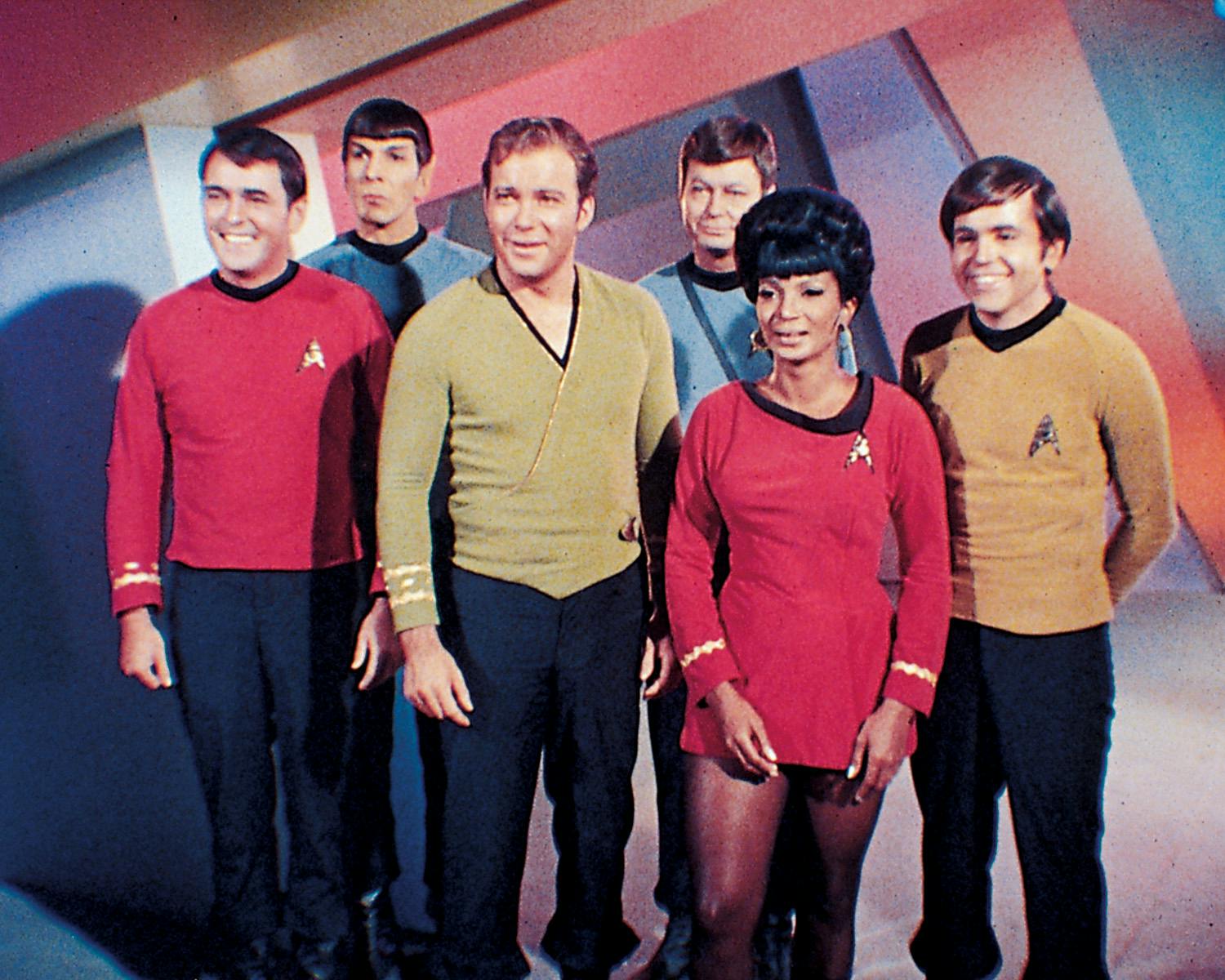
StarTrek.com
From there, the franchise grew and grew, spanning from and all the subsequent shows to , and everything in between. So, truly, you might not be reading this now, and might not be on the boards debating the merits of this Star Trek book or that Trek game had the Trimbles not stepped up to the plate back in 1968.
To mark the 55th anniversary of their campaign, StarTrek.com is revisiting our extensive interview with Bjo Trimble, conducted over email a few years ago, in which she talked about her life, love of sci-fi, the legendary letter writing campaign, and more!
StarTrek.com: To many people, you are the "woman who saved Star Trek." Obviously, somewhere along the line, you developed a keen interest in sci-fi. How did you discover it? What did/do you appreciate most about the genre? Were you more a fan of sci-fi prose or sci-fi film/TV?
Bjo Trimble: I’d always loved fairy tales, where everything worked out happily ever after. So it was an easy step into fantasy when I could find books. Since that was a subject that librarians deplored, there was not much fantasy available except Edgar Rice Burroughs’ John Carter of Mars series.
I was introduced to science fiction about 1946 or so, when I was being a brat about having to stay in bed to recover from flu. We lived in a trailer park where everything was parked pretty close, so noise carried. One of our neighbors was the Swedish Angel, a professional wrestler. His wife read sci-fi, and one day, [she] brought me a big stack of Astounding Science Fiction to shut me up. I had no idea what a robot or an alien was, or how a rocket ship worked, or that we ever hoped to get off this planet to visit strange new worlds. The stories were so exciting that I couldn’t give up on them, though I had to re-read them several times to figure out what was going on.
When I tried to find sci-fi in libraries, I discovered that it was the one thing that librarians deplored above fantasy! Then I found that drug stores sold sci-fi magazines. There were only 3 genres back then — fantasy, science fiction, and a sort of combination. I’d not have gone to any sci-fi movies then because all the family went to see were westerns and Disney films. There was nothing on TV for those who owned a blurry little black and white set that qualified as sci-fi.
StarTrek.com: Your involvement in sci-fi conventions and societies started well before Star Trek. How did that come about? And give us a sense of what you were involved in early on.
Bjo Trimble: My first convention was Chicon II in 1952, when I was a WAVE at USNTC Great Lakes. I was in the hospital with an infected ear when I saw a small blurb in Astounding Science Fiction about a convention that Labor Day weekend in Chicago. So I wrangled a 3-day pass, Radar O’Reilly style, and took off. I was technically AWOL, but nobody caught up with the paperwork until I’d returned.
At the convention, I met a bunch of other excited SF fans, including this bespectacled young man who had just sold his first short story. He decided he liked me and proposed on the spot. I said thank you, but no. His friends assured me that Harlan Ellison really meant marriage, and I assured them that I really meant no. I also met Robert Bloch, Wily Ley, August Derleth and several other writers at that wonderful convention. I was hooked on science fiction fandom!
Since I was an artist and cartoonist, fan editors quickly engaged me in the wonderful world of fanzines, where I drew many covers and interior illos for fan publications. I have also done an occasional professional illustration, too. Later on, John and I organized and directed the World Science Fiction Art Show at Worldcons for many years. That show is still going strong.
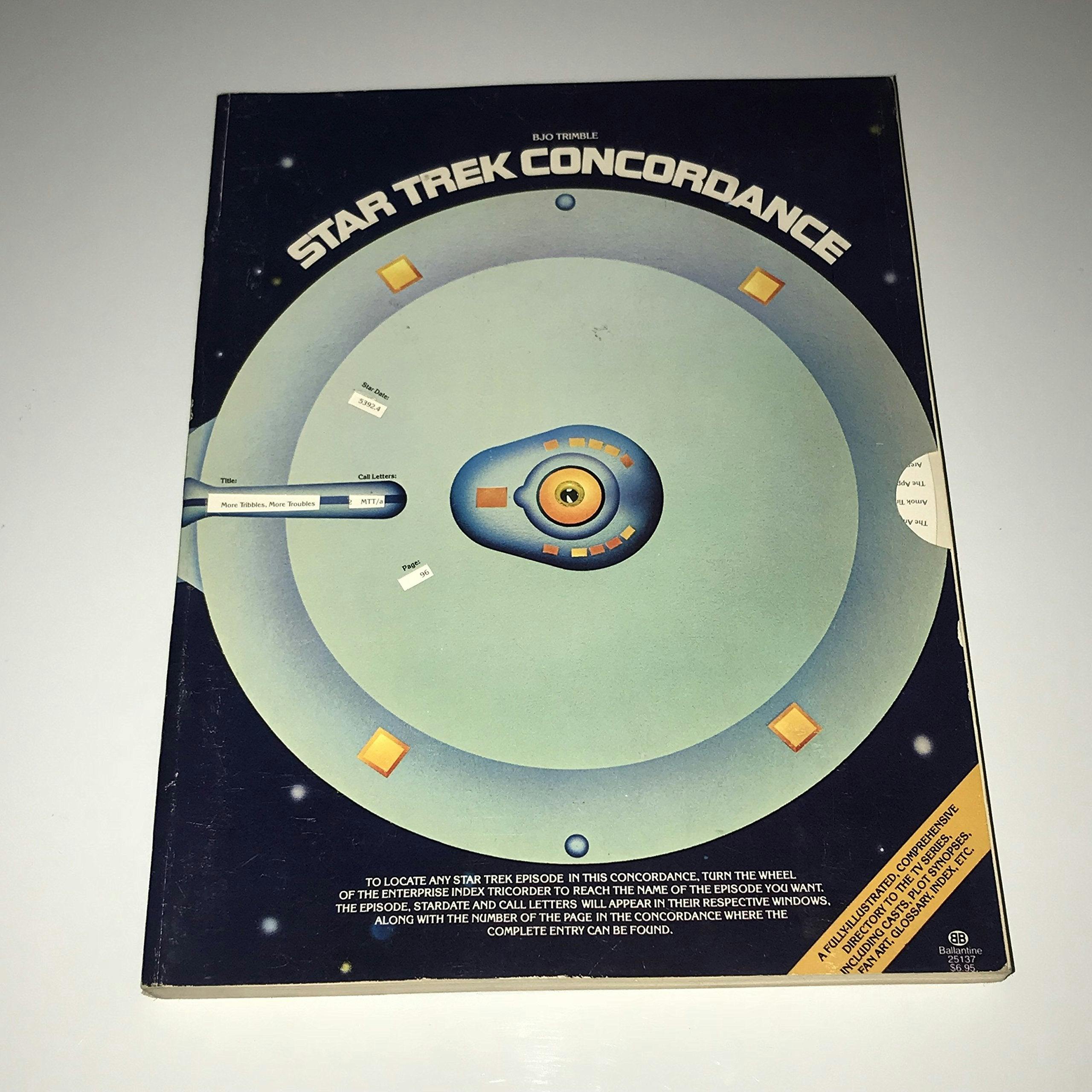
StarTrek.com
StarTrek.com: Somehow, John doesn't receive as much attention as he deserves. How did the two of you meet? When did it become apparent that you shared a love of sci-fi and fighting for things you believed in?
Bjo Trimble: John and I met under Forrest J. Ackerman’s baby grand piano. Forry was holding a very large, crowded party, and there was no place to sit. A group of fans snaffled some chips and crawled under the piano, where people wouldn’t step on us. John was in the Air Force, so he and I traded Stupid Office Stories and discovered we liked each other a lot. We knew right away that we both liked the same kind of science fiction, but discovered our willingness to fight for things as we went along. At first it was little things — city block zoning that was unfair to less wealthy home-owners, schools that needed voter support, things like that. By the time we devised the Save Star Trek letter-writing campaign, we were both in sync about what we wanted to do.
StarTrek.com: What's it meant to you to have John by your side for so long?
Bjo Trimble: It took awhile for us to decide to marry, but it’s lasted for 51 years this July, so we must be doing something right! It has meant everything to me to have John by my side because he is my closest friend. We don’t do well when we are separated for very long.
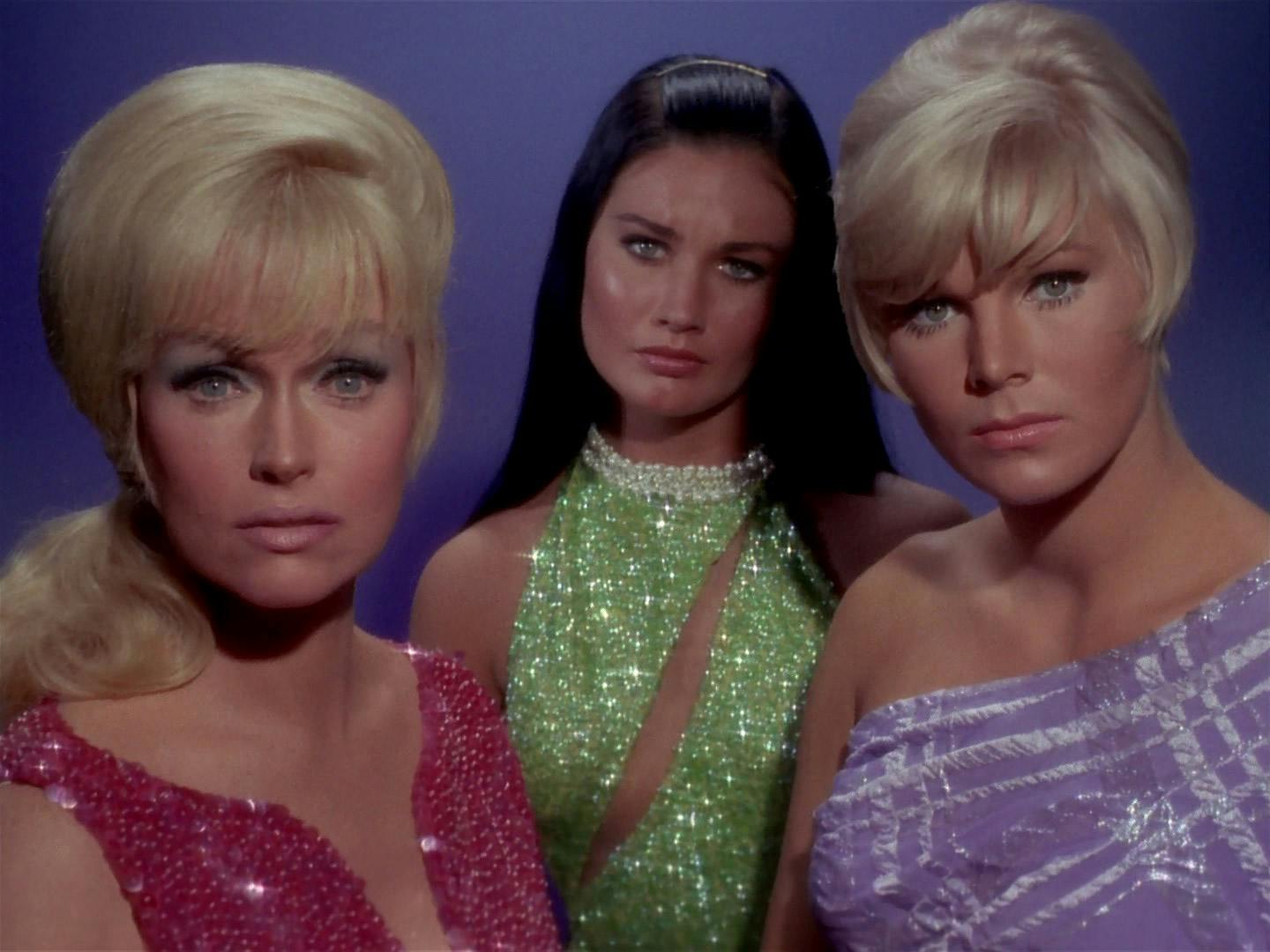
"Mudd's Women"
StarTrek.com
StarTrek.com: OK, how and when did Star Trek enter into your life?
Bjo Trimble: John and I were going to Tricon in Cleveland, 1966, to set up the Art Show. A friend was to handle a Futuristic Fashion Show, but she got appendicitis and that project went to me. At the convention, the con-com told me they had promised this Big Hollywood TV Producer that he could put three of his costumes in my fashion show, but since we were already so tight for time, I said no. None of us had any idea what show he was talking about; he was premiering three episodes at Tricon, but it had not yet been aired.
A little later, this big handsome man jollied me into putting his costumes in the show — two from "" and one from "" The upshot was that we made friends with Gene [Roddenberry], and afterward visited the Star Trek set fairly often when we all returned to California. Gene was thrilled that the fans liked his show since everyone in Hollywood was betting it would not last very long. In fact, there was a small letter campaign organized by Harlan Ellison and other science fiction writers when Star Trek was threatened at the end of the first season. Their main push was to save the only TV show that actually bought scripts from writers who knew the subject, so not many fans were involved. Details are hazy on just what happened, but NBC at least did not cancel the show, so it must have worked.
The whole Save Star Trek campaign was John’s fault. We had visited the Trek set, about when word sifted down that the show would be canceled at the end of the second season. So we watched actors do their stuff beautifully in front of the camera, then slump off looking depressed. On our way home, John said, "There ought to be something we could do about this!” Now, he’d been married to me long enough to know better. By the time we got back home, we’d mapped out a basic plan of action. So we called Gene Roddenberry to see if he was OK with this idea. Gene had just told his staff that it would be wonderful if there was just some way to reach to fans and get their support. So things began to happen. But all the news at that time was about Women’s Lib and "the little housewife speaking up," so the news media had little interest in a businessman. Reporters focused on me instead of John. To my sorrow, John has seldom gotten even the fan credit he so well deserves for his part in making the Star Trek we know now a reality for all of fandom.
StarTrek.com: What is it that you appreciated most about the original Star Trek series?
Bjo Trimble: The grown-up approach to the stories, instead of the standard "there’s an ugly alien, let’s kill it!" story that was so common. Star Trek presented the ugly alien as a loving mother, an amazing twist. We also liked the sense of wonder presented in an adult manner, plus the three-dimensional characters.
StarTrek.com: Many of us knew the Star Trek Concordance as our only real Trek reference guide for many, many years. What do you remember most of assembling the book and the reaction to it at the time?
Bjo Trimble: The Concordance started with a young lady taking copious notes on episodes as they were viewed. I started helping her. When she had shoeboxes full of 3x5 index cards, I suggested that we put together a sort of encyclopedia fanzine. But it began to take too long and she lost interest. When we finally produced the Concordance fanzine, I was foolish in giving the young lady all the writing credit, which was not entirely true. For subsequent publications of the book, she had no input at all. John and I produced the first fan-published edition on an offset press in our basement. If you purchased a copy and happened to be in town, you had to come to our house to collate your own book! One of the reasons for the delay was Gene Roddenberry’s removal from his own show for the third season. The new producer did not like Trek fans and refused to let me have any access to scripts. Then President Eisenhower died before the final episode was shown; it did not air until the opening of the late re-run season. So we had to wait until then to make notes on that final episode, then print a third-season supplement.
The fan reaction was about the same as anything that happens Trek-wise today — some fans loved the Concordance, others hated it and nitpicked it to death. Some of their criticism was valid, but a lot of it was simple jealousy that they had not thought of the idea. Subsequently, several worked on their own version, but Mike Okuda was the only one who ever gave us credit for our pioneering research into the subject.
StarTrek.com: Let's get more into to saving Star Trek. Take our younger readers back to what was happening with the show, with NBC, etc., and what you and John did to help alter the course of Star Trek and entertainment history.
Bjo Trimble: Back when only three networks controlled almost all of TVland, NBC had a stranglehold on every word that was said, every action that happened, on the TV shows they aired. An NBC censor was on hand to read all the scripts and go over all the costumes with a beady eye. For some reason, the Empty Suits at the Top were convinced that one glimpse of a belly-button would totally ruin the morals of American Youth. Considering what’s on the Internet today, it sounds positively Victorian.
NBC figured Gene Roddenberry for a loose cannon – and they were right. Gene was as iconoclastic as he could possibly get away with, and he suffered a fair amount of slings and arrows due to his unrelenting envelope-pushing. NBC was also convinced that Star Trek was watched only by drooling idiot 12-year olds with no buying power. They managed to ignore the fact that people such as Isaac Asimov, a multiple PhD, and a multitude of other intellectuals enjoyed the show. So, of course, the Suits were always looking for reasons to cancel shows they didn’t trust to be raging successes. They used faulty Neilson Rating numbers to “prove” that Star Trek was failing badly, and decided to cancel it. Fans decided to take action, and we did it very well, thank you very much! So well that NBC came on, in prime time, and made a voice-over announcement that Star Trek was not canceled… so please stop writing letters.
This was all accomplished before the Internet. Only the very rich had computers; many big corporations farmed their computer work out. We mimeographed newsletters and mailed them out to addresses we got from SF conventions, book dealers, and even some ST fan mail that Gene helped us obtain from the fan mail service that Paramount contracted with. The newsletters had guidelines for letters, and asked each person to write a letter and then pass the information along to at least 10 people, asking them to write a letter and pass the information on as well. Thus was the Rule of Ten born.
There is another weird anomaly of the TV biz — in the 1960s, any show that did not have three seasons was never re-run! So with three seasons of TOS in the can, it could go into re-runs. It is claimed that ST has never been out of syndication somewhere in the world in all these years. Saving TOS meant another series, then another, and so on. Then the movies, and more movies.

StarTrek.com
StarTrek.com: Millions of fans, of course, are forever appreciative of your efforts. What did Gene Roddenberry say to you? What have the TOS cast members said to you over the years?
Bjo Trimble: Gene and most of the TOS cast members all thanked us, with the exception of a couple of people who at that time did not much care for fans and found it annoying to admit that we had anything to do with their success. Desilu never acknowledged our existence, and neither had Paramount. Anytime we get to go to a premiere or party at Paramount, it’s due to someone in the ranks remembering us. As for the millions of appreciative fans, I suspect most of them have no idea who we are; all they see are a couple of Olde Pharts with nothing new or interesting to tell them.
StarTrek.com: One personal highlight for you must have been that day you were an extra, along with other fans, in . What was that day like?
Bjo Trimble: We were both invited to be in The Motion Picture, but John had to work. He has been very sorry to be so conscientious, since he was out of that job the next year. It was a real thrill to see all the excited fans and to meet the unfailingly polite and patient director, Robert Wise. Many fans framed their paychecks, throwing the Paramount accounting department into a real tizzy. I cashed my check; we had two small children to care for. The fans had a wonderful time on the recreation deck, playing with the games that were subsequently removed as not being useful to the plot. The professional extras were not particularly amused, but then, fans weren’t worrying about where our next job and next paycheck was coming from in the film industry.
We did so well that the planned two days of shooting was crammed into one long day. We are all in white, tan, or pale gray uniforms. So what did they serve us for lunch? BBQ chicken and watermelon! Most of the fans on the set enjoyed the organized chaos of being in a movie. There was one heart-stopping moment when an alien mask went missing, but it was found in the hands of a fan who was trying to find out where to give it back.
StarTrek.com: You wrote On The Good Ship Enterprise. What did it mean to you to recount your 15 years of involvement with Star Trek in book form? Any stories you couldn't tell then that you can now? And is the book still in print?
Bjo Trimble: I had lots of fun writing those stories – all of them true. It meant a lot to be able to share fun stories with fans. Oh, yes, there were stories I could not tell then that I could tell now! We’re not the kind who likes to tell or hint at scurrilous back-stage goings-on; we leave that for the gossips. We enjoy seeing fans laugh at the fun things that we can share about our days on the sets, and our interactions with the actors and other members of the show. The book is no longer in print, but a very nice fan is helping get it updated and put online as an ebook.
StarTrek.com: You also helped lead the charge to have the first U.S. shuttle called Enterprise. Take us through that experience.
Bjo Trimble: A couple of other fans actually started this project, but for some reason, they could not finish it, and asked us to take it over. We thought it was a good idea to make the public really aware of the space program by using a popular name for the first shuttle, and we took it on. This was quite a scramble because there was a hard deadline for getting the job done. Remember, this was back before home computers, so it was all done with typewriters and telephones.
When we knew the shuttle was truly going to be named Enterprise, all the official TV Trek people were invited out to Edwards Air Force Base on the California desert to see the roll-out. Except for the Trimbles, of course. However, science fiction authors Jerry Pournelle and Larry Niven insisted that we be invited to the reception and roll-out. John attended the reception, but he had to go back to work on roll-out day. I was given a Press Pass, since nobody could figure out what else to do with me. It was a huge thrill to know that Star Trek fandom had been such a big part in making this important step into near space, at least.
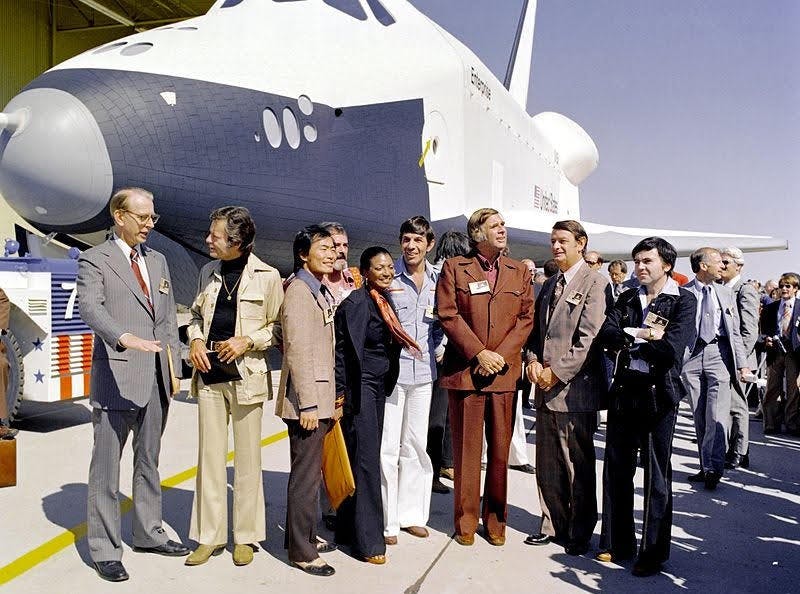
NASA
StarTrek.com: Post-TOS, how closely or not did you follow TNG, DS9, Voyager, Enterprise, the TNG features and, of course, the recent J.J. Abrams film?
Bjo Trimble: Very closely, and with great interest. We enjoyed TNG very much, really liked DS9 – which is still one of our favorite series – watched most of Voyager but didn’t get into it as much, and frankly thought that Enterprise was not even close to being Trek. We felt bad for those actors, who worked so hard against a tidal flow of bad decisions and unworkable scripts. Of the movies, some have been fairly good, some really horrid. The Powers That Be are convinced that they should never use anyone familiar with Trek for scripts, directing or any of those little production details. They say that what’s really needed is to get non-Trek writers and directors to “appeal to the non-Trek audience.” Which, of course, has assured that both Trekkers and non-Trekkers stayed away in droves.
Of course, we are always asked what we think of the J.J. Abrams film. We think he did pretty well, though we’re a tad tired of bald, tattooed villains in long leather coats. We understand that comic book characters and loud music is considered necessary pandering to the kids. Still, there is some lovely character development that we’d love to see in future movies – if we ever do see a second movie before the actors are ready for retirement! What we liked most about the Abrams film is that is opened up the entire Trek time plane into several other dimensions. Fans were upset about changes in canon, such as Uhura kissing Spock. Well, in the Trek-time we’re most used to, they never got together. In this alternate time, they did. We suggest that the fans trying to wrap their mind around this read a whole lot more time-travel sci-fi!
StarTrek.com: Fans still try to save favorite endangered shows — Roswell is an example, so is Jericho, and so was Enterprise. How different a mission would you say that is at this point, with Hollywood more business-driven than ever and the Internet in many ways usurping snail mail?
Bjo Trimble: This is a new world and has many new ways to do things. Hollywood can double-check on fan demographics faster than we can get a project together, even with the speed of the Internet. That, and a growing cynicism about selling TV time, makes it harder to create a really good push to save a show. The Rule of Ten still works, but now you can pop it into the Rule of One Thousand with the click of a computer button! Fans have forgotten the major credo of getting a studio’s or network’s attention — hit them in the bank account! Don’t just email the people responsible for canceling the show; their minds are made up. Write or email all those sponsors, big and small, who paid out for TV time for advertising. They don’t like to hear that you are unhappy with them; they want people to like them, and like their product. There are ways to do it, too. No threats, no rage, just polite requests. Be nice. Thank them for sponsoring your favorite show; businesses like to be thanked. But point out that if the show goes off the air, you will not be watching their interesting commercials. And besides, you are unhappy, and unhappy people don’t buy products. This works.
StarTrek.com: Any final thoughts you'd like to share with longtime fans and newcomers, too?
Bjo Trimble: Be kind. Be nice to each other. Be welcoming to newbies; they are the future of fandom, whatever you are a fan of. We hope that all of you are inspired to be a part of the future we may never see, inspired by a little TV show conceived by a far-seeing 20th Century writer and humanist. We are pleased to know that we have been a part of making sure it happened. We envy you the future, and wish we could come along on all of your new voyages of creativity and imagination.

